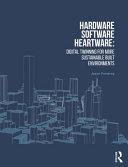Architecture & Design , Architectural Theory
Hardware, Software, Heartware
This richly illustrated book examines the full potential of Digital Twins (DTs) as a means of creating more sustainable urban habitats. It reveals how, in this digitally-enabled age, DTs are increasingly being adopted by cities as a tool for urban governance, with the hope of increasing operational efficiencies and enhancing citizens' lives. While the study and implementation of DTs has been critically explored as virtual, dynamic 3D replicas of physical entities across different disciplines and industries, this book establishes a strategy that recognises the need for the 'software' behind virtual DT platforms to not only represent the 'hardware' of our physical cities but also to reflect the 'heartware' of socio-economic and cultural practices. Knowledge gaps and challenges in existing DTs are identified and insights into rethinking their purpose are provided to propose a new DT paradigm model for city-wide application. With multiple case studies illustrating the different concepts of DTs being applied in cities from Europe, North America, The Middle East, Asia and Oceania, the book highlights the reasons why and how DTs can play an integral role in the sustainability of our urban habitats. Beautifully designed and illustrated in full colour throughout, this book combines academic theory with practical application and will be a useful reference for professionals, students, academics and policymakers, working in the fields of smart cities, sustainable urbanism, and the digitisation, digitalisation and digital transformation of the built environment industry.
- Pomeroy, Jason
- Taylor & Francis Limited
- 2023
- 250
- 9781032569383
Подкатегорије












